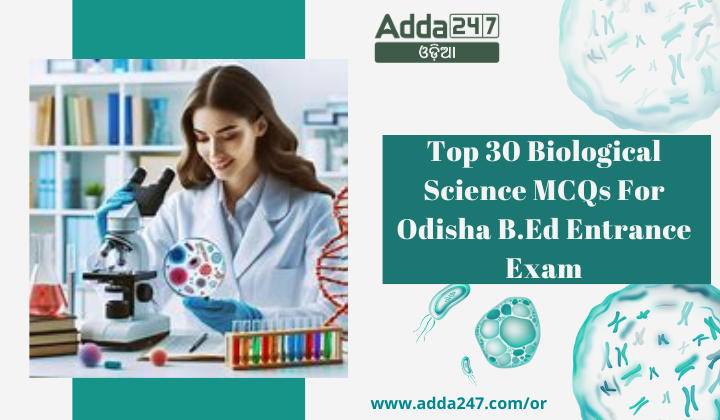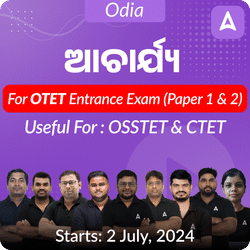Preparing for the Odisha B.Ed Entrance Exam in Biological Sciences requires a solid understanding of key concepts. The top 30 MCQs typically cover a range of topics including cell biology, genetics, evolution, ecology, and human physiology. These questions are designed to test both fundamental knowledge and application skills. For instance, you might encounter questions on the structure and function of cell organelles, Mendelian genetics, Darwinian theory, ecological interactions, and the human circulatory system. Mastering these areas through targeted MCQ practice can enhance your exam readiness and boost your confidence in tackling complex biological concepts.
Top 30 Biological Science MCQs For Odisha B.Ed Entrance Exam 13 July 2024
- Which organelle is known as the powerhouse of the cell?
(a) Nucleus
(b) Mitochondria
(c) Ribosome
(d) Golgi apparatus
Ans: (b) Mitochondria - The cell wall is found in which type of cell?
(a) Animal cell
(b) Plant cell
(c) Both animal and plant cells
(d) Neither animal nor plant cells
Ans: (b) Plant cell - Which component of the cell contains genetic material?
(a) Cytoplasm
(b) Cell membrane
(c) Nucleus
(d) Endoplasmic reticulum
Ans: (c) Nucleus - Which of the following is a prokaryotic organism?
(a) Algae
(b) Bacteria
(c) Fungi
(d) Protozoa
Ans: (b) Bacteria - What is the main function of the ribosome?
(a) Photosynthesis
(b) Protein synthesis
(c) Lipid synthesis
(d) Carbohydrate synthesis
Ans: (b) Protein synthesis - Which structure in the plant cell is responsible for photosynthesis?
(a) Mitochondria
(b) Chloroplast
(c) Golgi apparatus
(d) Lysosome
Ans: (b) Chloroplast - Which group of animals is characterized by having a notochord?
(a) Arthropods
(b) Mollusks
(c) Chordates
(d) Echinoderms
Ans: (c) Chordates - In which kingdom would you classify an organism that is multicellular, heterotrophic, and lacks a cell wall?
(a) Plantae
(b) Fungi
(c) Animalia
(d) Protista
Ans: (c) Animalia - What term is used for the variety of different species of plants and animals in a given habitat?
(a) Biodiversity
(b) Ecosystem
(c) Biome
(d) Community
Ans: (a) Biodiversity - Which of the following is a renewable natural resource?
(a) Coal
(b) Oil
(c) Wind energy
(d) Natural gas
Ans: (c) Wind energy - Which of the following cycles involves the movement of nitrogen through the environment?
(a) Carbon cycle
(b) Nitrogen cycle
(c) Water cycle
(d) Phosphorus cycle
Ans: (b) Nitrogen cycle - The process by which green plants convert carbon dioxide and water into glucose is known as:
(a) Respiration
(b) Photosynthesis
(c) Transpiration
(d) Digestion
Ans: (b) Photosynthesis - In an ecosystem, which of the following is considered a producer?
(a) Herbivores
(b) Carnivores
(c) Plants
(d) Decomposers
Ans: (c) Plants - What is the term for the gradual buildup of pollutants in the environment?
(a) Bioaccumulation
(b) Biodegradation
(c) Biomagnification
(d) Bioremediation
Ans: (a) Bioaccumulation - Which type of pollution is caused by excessive nutrients in water bodies leading to algal blooms?
(a) Air pollution
(b) Soil pollution
(c) Water pollution
(d) Noise pollution
Ans: (c) Water pollution - Which process is involved in the breakdown of glucose to release energy in cells?
(a) Photosynthesis
(b) Respiration
(c) Fermentation
(d) Glycolysis
Ans: (b) Respiration - Which organ in the human body is primarily responsible for filtering blood?
(a) Heart
(b) Liver
(c) Kidneys
(d) Lungs
Ans: (c) Kidneys - What is the main purpose of excretion in living organisms?
(a) To obtain energy
(b) To remove waste products
(c) To reproduce
(d) To grow
Ans: (b) To remove waste products - Which of the following is a primary consumer in a food chain?
(a) Grass
(b) Deer
(c) Lion
(d) Fungi
Ans: (b) Deer - The biogeochemical cycle involving the movement of water through the environment is known as:
(a) Water cycle
(b) Carbon cycle
(c) Nitrogen cycle
(d) Phosphorus cycle
Ans: (a) Water cycle - Which type of organism breaks down dead organic matter and recycles nutrients back into the ecosystem?
(a) Producers
(b) Consumers
(c) Decomposers
(d) Predators
Ans: (c) Decomposers - In which part of the cell does respiration take place?
(a) Nucleus
(b) Chloroplast
(c) Mitochondria
(d) Ribosome
Ans: (c) Mitochondria - What is the process called when plants release water vapor into the atmosphere?
(a) Photosynthesis
(b) Respiration
(c) Transpiration
(d) Evaporation
Ans: (c) Transpiration - What type of natural resource is coal?
(a) Renewable
(b) Non-renewable
(c) Biotic
(d) Abiotic
Ans: (b) Non-renewable - Which cycle is associated with the movement of carbon through living organisms and the environment?
(a) Water cycle
(b) Carbon cycle
(c) Nitrogen cycle
(d) Sulfur cycle
Ans: (b) Carbon cycle - What is the primary function of the small intestine in animals?
(a) Digestion and absorption of nutrients
(b) Filtration of blood
(c) Production of red blood cells
(d) Excretion of waste products
Ans: (a) Digestion and absorption of nutrients - Which gas is primarily responsible for the greenhouse effect?
(a) Oxygen
(b) Nitrogen
(c) Carbon dioxide
(d) Methane
Ans: (c) Carbon dioxide - Which of the following is an abiotic component of an ecosystem?
(a) Plants
(b) Animals
(c) Soil
(d) Bacteria
Ans: (c) Soil - What is the process by which living organisms maintain a stable internal environment?
(a) Metabolism
(b) Homeostasis
(c) Adaptation
(d) Evolution
Ans: (b) Homeostasis - Which of the following is an example of environmental degradation?
(a) Reforestation
(b) Pollution
(c) Conservation
(d) Sustainable development
Ans: (b) Pollution





